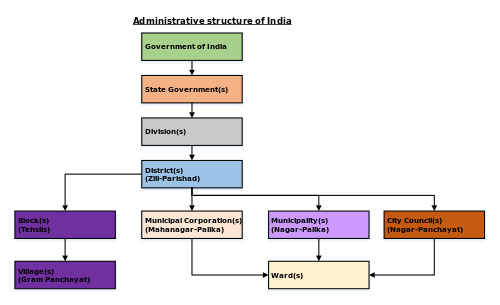District Councils of India
 |
| This article is part of a series on the politics and government of India |
|
|
Zila Panchayats are Panchayats at Apex or District Level in Panchayat Raj Institutions (or PRIs).
The 73rd Amendment is about Rural Local Governments (which are also known as Panchayati Raj Institutions or PRIs)
- Panchayat at District(or apex) Level
- Panchayat at Intermediate Level
- Panchayat at Base Level
The Zila Panchayat or District Council or Zilla Parishad or District Panchayat, is the third tier of the Panchayati Raj system. Zila Parishad is an elected body. Block Pramukh(president) of Panchayat Samiti (Block) are also represented in Zila Parishad. The members of the State Legislature and the members of the Parliament of India are members of the Zila Parishad.
Constitution

Members of the Zila Parishad are elected from the district on the basis of adult franchise for a term of five years. Zila Parishad has minimum of 50 and maximum of 75 members. There are seats reserved for Scheduled Castes, Scheduled Tribes, backward classes and women. These Councillors chosen by direct election from electoral divisions in the District.
The Chairmen of all the Panchayat Samitis under the district are the Ex-Officio members of Zilla Parishad. The Parishad is headed by a President and a Vice-President.
The Deputy Chief Executive Officer from General Administration department at district level is ex-Officio Secretary of Zilla Parishad.
The Chief Executive Officer, who is an IAS Officer or Senior State Service Officer heads the administrative set up of the Zilla Parishad. He supervises the divisions of the Parishad and is assisted by Deputy CEOs and other Officials at district and block level officers.
Administrative structure
The Chief Executive Officer (CEO), who is an IAS or a State Civil Service officer, heads the administrative machinery of the Zila Parishad. He may also be District Magistrate in some states. The CEO supervises the divisions of the Parishad and executes its development schemes.
Functions
- Provide essential services and facilities to the rural population and the planning and execution of the development programmes for the district.
- Supply improved seeds to farmers. Inform them of new techniques of training. Undertake construction of small-scale irrigation projects and percolation tanks. Maintain pastures and grazing lands.
- Set up and run schools in villages. Execute programmes for adult literacy. Run libraries.
- Start Primary Health Centres and hospitals in villages. Start vaccination drives against epidemics and family welfare campaigns.
- Construct bridges and roads.
- Execute plans for the development of the scheduled castes and tribes. Run ashramshalas for adivasi children. Set up free hostels for scheduled caste students.
- Encourage entrepreneurs to start small-scale industries like cottage industries, handicraft, agriculture produce processing mills, dairy farms, etc. Implement rural employment schemes.
- They even supply work for the poor people.(tribes,scheduled caste,lower caste)
Sources of income
- Taxes on water, pilgrimage, markets, etc.
- Fixed grant from the State Government in proportion with the land revenue and money for works and schemes assigned to the Parishad.
- The Zila Parishad can collect some money from the panchayats with the approval of the government.
- It gets a share from the income from local taxes.
References
- Our Civic Life (Civics and Administration) Maharashtra State Bureau of Textbook Production and Curriculum Research, Pune